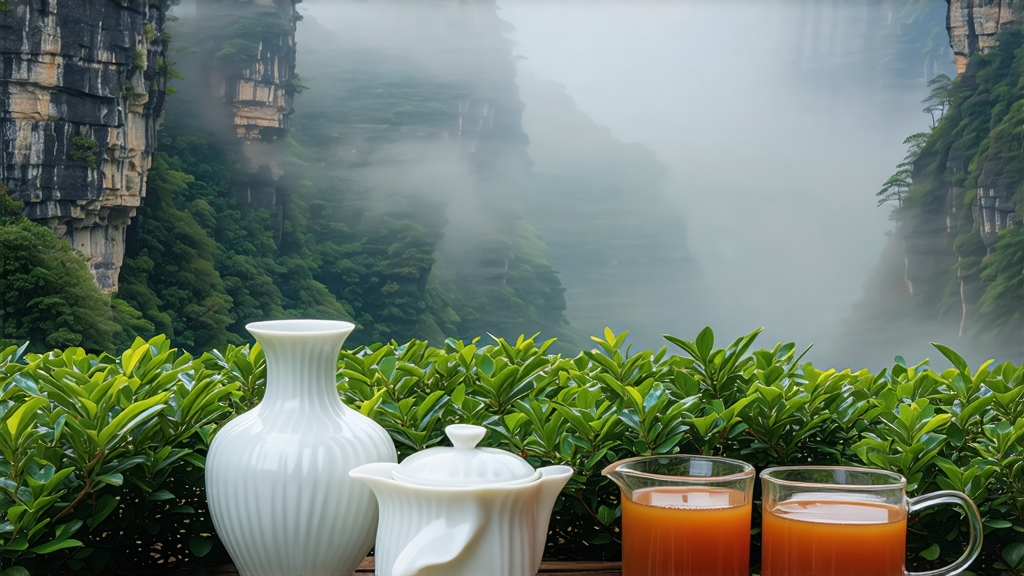
High in the Wuyi Mountains of northern Fujian, where the Nine-Bend River coils like a jade ribbon around crimson cliffs, tea is not merely grown—it is composed, the way a symphony is written note by note. Among the hundreds of oolong songs that echo through these volcanic gorges, none carries the mythic weight of Da Hong Pao, literally “Big Red Robe.” International drinkers often meet it first through ornate tins at airport gift shops, yet the true Da Hong Pao is less a product than a living lineage, a taste of Ming-dynasty stone and Song-dynasty mist that refuses to be bottled by simple commerce. To understand it is to step into a story that begins with a monk’s gratitude, passes through imperial examination halls, and ends—if tea stories ever end—in the quiet steam of a gaiwan on a rainy afternoon.
Legend dates the name to 1385, when a Ming imperial scholar, stricken with fever on his way to the capital, was revived by a brew made from six bushes clinging to a narrow ledge of Tianxin Cliff. Upon earning the highest jinshi degree, he returned in vermillion robes to drape the bushes in gratitude; the crimson silk bleached under mountain sun, yet the name stuck. Qing-era records list these mother trees as tribute tea; in 1927 warlord Wu Peifu posted guards to protect them, and in 2006 the Chinese government ceased all plucking from the surviving originals, preserving their gnarled trunks as national monuments. What circulates today are not leaves from those relics—only 20 g of their harvest was ever auctioned, fetching US 30 000 per gram in 2005—but descendants propagated through three channels: cuttings (qiezhi), seeds (shizai), and grafting (yazhi). Purists speak of “Pure Blood” (chunzhong) Da Hong Pao when every leaf can be traced to those first six bushes via asexual cuttings, while “Blended Blood” (peifang) marries several Wuyi cultivars to recreate the mother tree’s profile. Both are authentic in the eyes of local farmers, provided they grow within the 60 km² UNESCO core zone whose mineral soil gives the tea its signature yan yun—literally “rock rhyme,” a lingering limestone coolness that arrives after swallowing, as though the mountain itself were exhaling inside your throat.
The cultivars most often folded into peifang recipes are Qidan, Beidou, and Que She, each contributing facets of aroma: Qidan supplies dark orchid and burnt caramel, Beidou adds bright apricot, while Que She lengthens the finish with white pepper. Regardless of lineage, every genuine leaf must survive a six-act drama of craft that begins under the full moon of late April. Pickers climb bamboo ladders at dawn, selecting the open-face triad of leaf, stem, and bud known as zhongkai, when the leaf’s edge is slightly serrated like a cat’s tongue but still tender enough to fold without cracking. The first act, wilting (wei diao), spreads the harvest on bamboo trays in shallow caves where mountain breezes lower moisture to 65 % without direct sun, preserving the purple-green chlorophyll that will later transmute into amber pigments. Next comes yao qing, “rocking the green,” a bruising ritual once performed by barefoot monks who danced in wicker baskets; today machines toss the leaves for three minutes, rest for seven, repeating eight cycles until the edges oxidize to a copper rim while the centers remain jade. This partial oxidation—hovering between the 30 % of green tea and the 80 % of black—defines oolong, yet in Wuyi the goal is not a fixed number but a living curve: the leaf must smell of green apple at 20 %, of peach at 35, of honey at 45, at which point the master halts the process by thrusting the leaves into a 220 °C electric roaster for three seconds, a shock called sha qing that locks the aromatics like a photographer stopping motion with flash.
What follows distinguishes yancha from all other oolongs: three consecutive roasts over 80 hours using only local hardwood charcoal made from Japanese chestnut. The first bake (zha huo) at 120 °C drives residual moisture to 7 %; the second (fu huo) at 90 °C for ten hours co